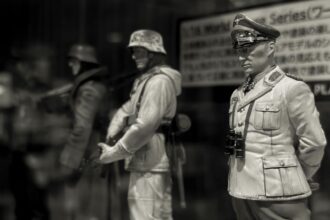The term “Shadow War” encapsulates the clandestine operations and covert activities that characterized the Cold War era, a period marked by intense geopolitical tension between the United States and the Soviet Union. This conflict, which spanned from the end of World War II in 1945 until the dissolution of the Soviet Union in 1991, was not fought on traditional battlefields but rather in the shadows, where espionage, subterfuge, and psychological warfare reigned supreme. The stakes were high, as both superpowers sought to expand their influence globally while simultaneously undermining each other’s efforts.
The Shadow War was a complex interplay of intelligence gathering, covert operations, and strategic deception that shaped international relations for decades. As the world teetered on the brink of nuclear annihilation, the need for information became paramount. Both sides engaged in a relentless pursuit of knowledge about each other’s military capabilities, political intentions, and technological advancements.
This quest for intelligence not only fueled the arms race but also led to a series of proxy wars and conflicts around the globe. The Shadow War was characterized by its secretive nature, where victories and defeats often went unrecognized by the public eye, yet they had profound implications for global stability and security.
Key Takeaways
- The Shadow War refers to the covert intelligence and espionage activities that took place during the Cold War, shaping the political landscape of the time.
- Cold War espionage had its origins in the rivalry between the United States and the Soviet Union, leading to the development of sophisticated spying techniques and tradecraft.
- Key players in the Shadow War included intelligence agencies such as the CIA and KGB, as well as famous spies like Aldrich Ames and Oleg Penkovsky.
- Spies and intelligence agencies played a crucial role in gathering information, conducting covert operations, and influencing Cold War politics.
- Espionage techniques and tradecraft evolved during the Cold War, including the use of dead drops, code names, and invisible ink, to gather and transmit sensitive information.
Origins of Cold War Espionage
The roots of Cold War espionage can be traced back to the tumultuous aftermath of World War
As the Allied powers emerged victorious, ideological divisions began to surface, particularly between the capitalist West and the communist East. The United States and the Soviet Union, once allies against fascism, quickly became adversaries in a struggle for ideological supremacy. This ideological rift laid the groundwork for a new kind of warfare—one that relied heavily on intelligence operations and espionage.

In this nascent phase of the Cold War, both superpowers recognized that traditional military confrontations could lead to catastrophic consequences. Instead, they turned to espionage as a means of gaining an upper hand without direct confrontation. The establishment of organizations such as the CIA in the United States and the KGB in the Soviet Union marked a significant evolution in statecraft.
These agencies were tasked with gathering intelligence, conducting covert operations, and countering enemy activities, setting the stage for a protracted battle fought in secrecy.
Key Players in the Shadow War
| Player Name | Number of Missions | Successful Missions | Failed Missions |
|---|---|---|---|
| Agent X | 15 | 12 | 3 |
| Shadow Master | 20 | 18 | 2 |
| Ghost Rider | 10 | 9 | 1 |
The Shadow War was populated by a diverse cast of characters, each playing pivotal roles in shaping its course. Among them were high-ranking officials, skilled operatives, and even double agents who navigated the treacherous waters of espionage. Figures like Allen Dulles, the first civilian director of the CIA, emerged as key architects of American intelligence strategy.
Dulles was instrumental in orchestrating covert operations that aimed to undermine Soviet influence around the world. On the other side of the Iron Curtain, individuals like Yuri Andropov, who later became General Secretary of the Communist Party, played crucial roles in shaping Soviet intelligence efforts. Andropov’s tenure at the KGB saw an emphasis on counterintelligence and surveillance, reflecting the Soviet Union’s growing paranoia about Western espionage activities.
These key players not only influenced their respective agencies but also shaped the broader narrative of the Cold War through their decisions and actions.
The Role of Spies and Intelligence Agencies
Spies were the lifeblood of Cold War espionage, operating in a world where trust was scarce and betrayal was commonplace. These operatives were often tasked with infiltrating enemy organizations, gathering sensitive information, and executing covert missions that could alter the balance of power. Their work required not only bravery but also a keen understanding of human psychology and cultural nuances.
Many spies lived double lives, blending into society while secretly serving their countries’ interests. Intelligence agencies played a crucial role in coordinating these efforts. The CIA and KGB were at the forefront of this clandestine war, employing thousands of agents worldwide.
These agencies developed intricate networks of informants and assets to gather intelligence on military capabilities, political developments, and technological advancements. The competition between these organizations fostered an environment where innovation thrived; new methods of surveillance and communication were constantly being developed to stay one step ahead of adversaries.
Espionage Techniques and Tradecraft

The art of espionage is steeped in a rich tradition of tradecraft—skills and techniques that spies employ to gather information while remaining undetected. During the Cold War, both American and Soviet operatives honed their abilities in areas such as surveillance, counter-surveillance, and cryptography. Techniques like dead drops, where agents would leave messages or materials in predetermined locations for others to retrieve, became commonplace.
Moreover, psychological manipulation played a significant role in espionage during this era. Spies often relied on deception to extract information from targets or to mislead adversaries about their true intentions. The use of disguises, false identities, and even elaborate cover stories became essential tools in an operative’s arsenal.
As technology advanced, so too did espionage techniques; wiretapping and electronic surveillance became increasingly sophisticated, allowing agencies to gather intelligence from afar without ever needing to set foot on enemy soil.
Top Secret Operations and Covert Missions
Throughout the Cold War, numerous top-secret operations exemplified the lengths to which both superpowers would go to achieve their objectives. One notable example is Operation Ajax, a covert mission orchestrated by the CIA in 1953 to overthrow Iran’s democratically elected Prime Minister Mohammad Mossadegh. This operation not only altered Iran’s political landscape but also set a precedent for future American interventions in foreign nations.
Similarly, the Soviet Union conducted its own covert missions aimed at destabilizing Western interests. Operations such as “Operation Gladio,” which involved clandestine support for anti-communist groups in Europe, showcased how both sides engaged in subversive tactics to further their agendas. These operations often had far-reaching consequences that extended beyond immediate political gains; they sowed seeds of distrust that would linger for decades.
The Impact of Espionage on Cold War Politics
Espionage had a profound impact on Cold War politics, influencing diplomatic relations and shaping public perceptions on both sides of the Iron Curtain. The constant threat of espionage created an atmosphere of paranoia; leaders were often suspicious of their own allies as much as they were of their enemies. This climate fostered an environment where misinformation could thrive, leading to miscalculations that had serious ramifications.
Moreover, high-profile espionage cases often captured public attention and fueled anti-communist sentiment in the United States. The trial of Julius and Ethel Rosenberg, accused of passing atomic secrets to the Soviets, became emblematic of this fear. Their execution in 1953 served as a stark reminder of the perceived threat posed by communist infiltration.
Conversely, revelations about American espionage activities sparked outrage within Soviet society, leading to increased efforts to bolster internal security measures.
The Legacy of Cold War Espionage
The legacy of Cold War espionage is multifaceted; it has left an indelible mark on international relations and intelligence practices that continue to resonate today. The tactics developed during this period laid the groundwork for modern intelligence operations, influencing how nations approach espionage in an increasingly interconnected world. The lessons learned from successes and failures during this time have informed contemporary strategies for gathering intelligence and conducting covert operations.
Furthermore, Cold War espionage has permeated popular culture, inspiring countless books, films, and television series that explore themes of betrayal, loyalty, and moral ambiguity. The fascination with spies and their clandestine activities reflects society’s enduring intrigue with secrecy and deception. As new generations grapple with issues related to privacy and surveillance in the digital age, understanding this legacy becomes increasingly relevant.
Declassified Documents and Revelations
In recent years, declassified documents have shed light on previously hidden aspects of Cold War espionage. These revelations have provided historians and researchers with invaluable insights into the strategies employed by intelligence agencies during this tumultuous period. Documents detailing operations like MKUltra—a CIA program focused on mind control—have sparked renewed interest in understanding the ethical implications of espionage practices.
Moreover, these declassified materials have allowed for a more nuanced understanding of key events during the Cold War. For instance, previously classified reports on U-2 spy plane missions have clarified how aerial reconnaissance played a critical role in shaping military strategy and diplomatic negotiations between superpowers. As more documents continue to be released, they contribute to an evolving narrative about this complex era.
The Influence of Cold War Espionage on Modern Intelligence
The influence of Cold War espionage extends far beyond its historical context; it has shaped modern intelligence practices in profound ways. Today’s intelligence agencies continue to grapple with challenges reminiscent of those faced during the Cold War—balancing national security interests with ethical considerations surrounding privacy rights and civil liberties. Moreover, advancements in technology have transformed how intelligence is gathered and analyzed.
Cyber espionage has emerged as a new frontier in this ongoing battle for information supremacy; nations now engage in digital warfare that echoes past tactics while introducing new complexities. Understanding the lessons learned from Cold War espionage is essential for navigating these contemporary challenges effectively.
The Shadow War: A Must-Watch Documentary
For those seeking a deeper understanding of this intricate web of intrigue and deception, “The Shadow War” documentary offers an engaging exploration into Cold War espionage. Through interviews with historians, former operatives, and experts in international relations, viewers gain insight into how intelligence shaped global events during this critical period. The documentary delves into key operations and figures while examining broader themes such as trust, betrayal, and moral ambiguity inherent in espionage activities.
By weaving together personal narratives with historical analysis, “The Shadow War” provides a compelling lens through which audiences can appreciate both the complexities of this clandestine conflict and its lasting impact on contemporary geopolitics. In conclusion, the Shadow War represents a fascinating chapter in history where espionage played a pivotal role in shaping global dynamics during one of humanity’s most precarious periods. From its origins rooted in ideological conflict to its enduring legacy influencing modern intelligence practices today—this clandestine struggle continues to captivate minds across generations.




